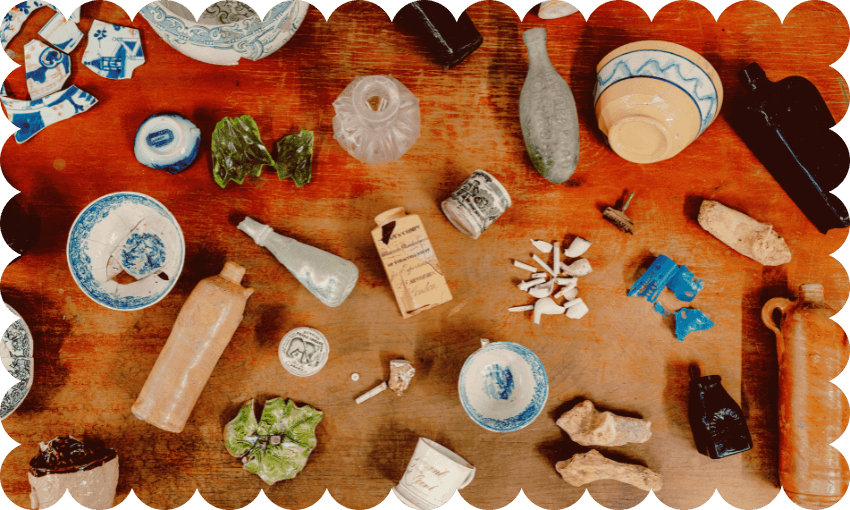Close to a million artefacts found in post-quake Christchurch are now available to be viewed by the public. Alex Casey speaks to the founder of Museum of Archeology Ōtautahi.
Charles Henry Cox would’ve got away with it, if it hadn’t been for those damn meddling archeologists. The talented grifter proudly advertised his own patented brand of shoe polish to the people of Ōtautahi in the late 1880s but, as Dr Katharine Watson and her team would discover over 120 years later, it was all a ruse. “We found 35 bottles of Hathaways shoe polish on the site where he and his family lived,” she explains. “Now, that’s way more shoe polish than any family is ever going to go through in a lifetime.”
As they kept excavating on the site, they found a similar number of stoneware bottles nearby. A quick look through Papers Past revealed that Cox had in fact been “committing really low level fraud” at the time by selling off someone else’s brand of shoe polish as his own. “Clearly, what he’d been doing was buying up the Hathaways shoe polish in bulk, maybe adding something to it, or maybe just repackaging it and selling it,” she laughs of the grift. “The business didn’t last very long, but it’s a pretty crazy story.”
This is just one of nearly a million fascinating archeological finds that have been unearthed over the last 13 years of post-quake excavation. Watson established the company Underground Overground Archeology that, prior to 2011, employed just three people. In the months and years following the devastating Christchurch earthquakes, which saw 185 people killed, 100,000 buildings damaged and 10,000 demolished, Watson took on over 20 archeologists to help oversee 466 vulnerable heritage sites across the city.
“I didn’t have any idea how big this would become, but I knew that this was something that was pretty significant for not just archaeology, but for us as New Zealanders to understand our past,” she says. Over the next decade, they would find hundreds and thousands of historic relics including old scary dollies and chamber pots, plates and Ballantynes signage, Schweppes bottles and smoking paraphernalia. “Even things like old road layers and tramways and drains, which don’t sound that interesting, but are actually surprisingly interesting.”
Still, Watson has her favourites. “The stories that I really love the most are of the women who are often so hidden in the historical record, but we’re finding them through archaeology,” she says. One house in Beveridge Street revealed the story of a late 1800s housewife who started her own business in Colombo Street, and then earned so much money that she was able to upgrade her family home and buy them a beach house in New Brighton. “I love those stories that are about women making their own way in the world at a time like that.”
Another curiosity is a “badass” clay tobacco pipe shaped like a skull, complete with one bright blue glass eye, found on the site of the justice and emergency services precinct in the city. “It used to be a factory site, so you can imagine a factory worker sitting there and smoking this pipe and you can also imagine what you’re saying about yourself when you smoke a pipe like that,” she says. “There’s a real power in holding an object that was last used 150 years ago, and thinking about that person and their life choices and where they came from.”
The public will now also have the chance to peruse the collection digitally in the newly-launched Museum of Archaeology Ōtautahi. “We want people to use the website as much as they possibly can,” says Watson. “No matter who you are, you’re bound to find something of interest.” Ultimately, she says this is just the first step of a much bigger plan to further develop research and education around the collection, find sustainable long term storage, and eventually open a physical museum where people can see the objects for themselves.
As for why it is so crucial to preserve what some might dismiss as old broken junk? “Archeology provides another avenue into the past that might be different from what history tells us,” says Watson. “It’s often information that wasn’t recorded in any other way, like what people were eating or what they were eating off. That might sound really mundane, but by looking at these things we can start to explore much bigger patterns to do with colonialism, consumerism, and how Christchurch shaped its identity.”
Or, to put it another way, “it all helps us understand who we are today.”



